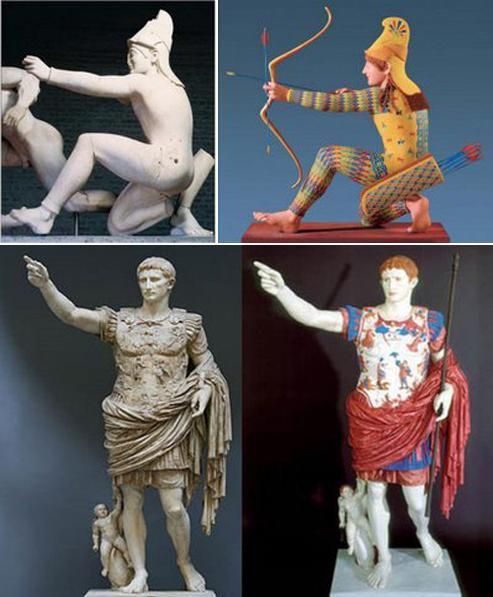这位是凯撒·奥古斯都。
He was the first official emperor of the Roman Empire.
罗马帝国的第一位官方皇帝。
And if you’ve ever had to study Roman history,
如果你也学过罗马史,
You might be familiar with this little sculpture’s very famous original.
那你可能已经见过这个小雕像的原件了,毕竟名气在那里的对吧。
It’s called the “Augustus of Prima Porta.”
原作名为《第一门的奥古斯都像》。
It was carved in the 1st century AD, during his reign as emperor.
雕刻于公元1世纪,也即奥古斯都在位期间。
Then it was lost to time, before it was dug up in the 1860s.
之后它便消失了,直到19世纪60年代才被重新挖掘出来。
Today it lives in the Vatican Museums, alongside a bunch of other famous sculptures.
如今,这座雕像正陈列在梵蒂冈博物馆里,和其他的著名雕塑并肩而列。
But Augustus? He’s not supposed to look like this.
问题是,奥古斯都原来并不是这个样子。
He’s supposed to look like this.
而是这个样子。
Let’s get this out of the way: Ancient Greece and Rome were really colorful.
这点我们暂且放一放,其实,古希腊和古罗马人对颜色是非常热衷的。
Their buildings were full of intricate frescoes and elaborate mosaics
他们的建筑都装饰满了错综复杂的壁画,精美的马赛克拼贴画,
and covered with vibrantly painted statues, of things like epic battles, glimmering gods, and pretty flowers.
还覆盖满了笔触鲜艳的雕画,而雕画画的都是史诗般的战斗故事啦,闪闪发光的神灵啦,还有漂亮的花儿等等。
But today, most of us picture something more like this - brilliant white marble as far as the eye can see.
不过,如今,想到古希腊古罗马雕像,你我中间的大多数人想到的都是这种——一水儿的白色大理石雕像。
We’re wrong.
其实,我们都错了。
But it’s not our fault.
但其实错也不在我们。
It’s Hollywood’s fault and our high school textbooks’ fault.
错在好莱坞和我们的高中课本。
But most of all, it’s this guy’s fault.
不过最大的错还是这位哥们儿的错。
Well, not him. He’s just a statue.
嗯,其实也算不上他的错啦,毕竟,他只是个雕像而已。
The blame lies with Michelangelo, the guy who sculpted him.
真正的罪魁祸首是米开朗其罗,也就是创造他的人。
And with many others who made white marble statues during the Renaissance.
不过,除了他,还有很多文艺复兴时期雕刻白色大理石雕像的人都与这事儿脱不了干系。
When European artists, philosophers, and scientists developed a renewed interest in the creations of classical Greece and Rome.
那是一个欧洲的画家、哲学家和科学家普遍对古希腊古罗马时期的作品重燃兴趣的时代。
Artists like Michelangelo began studying Roman sculptures - like this one: “Laocoön and his Sons.”
米开朗其罗等画家都在研究古罗马雕塑,比如这座《拉奥孔和他的儿子们》。
They fell in love with its lifelike figures, dramatic scene, and pristine, white surface.
他们爱上了这座雕像栩栩如生的外貌、描绘的戏剧性场景,还有它那纯净的白色外表。
But sculptures like this weren’t meant to be white.
问题是,这样的雕像原本并非白色。
Their paint had just faded after being buried or left out in the open air for hundreds of years.
只是,经过数百年的掩埋或是暴露,它们原来的颜色已经褪掉了。
So when the Renaissance artists set out to imitate them, they left their masterpieces bare too.
而文艺复兴时期的画家们是模仿它们进行创作的,所以他们的杰作也就都没有用其他的色彩。
And that style took over, inspiring generations of sculptors.
后来,这种画法逐渐风靡,成了一代又一代雕刻家的灵感源泉。
White marble became the norm.
白色大理石也由此成了雕刻用的标准材料。
Along the way, art historians reinforced this bias.
加上艺术历史学家们敲边鼓,这一成见就更深了。
Namely this guy - Johann Joachim Winckelmann.
准确地说,敲边鼓的是这位哥们儿——约翰·约阿辛·温克尔曼。
He’s sometimes known as the father of Art history.
有时,人们又称他为“艺术史之父”。
In the 18th century, he wrote a hugely influential book on ancient art.
18世纪的时候,他写了一本关于古代艺术的书,影响颇大。
In it he argued that statues like this one - the Apollo of Belvedere - were the epitome of beauty.
他在书中辩称,《贝尔维德尔的阿波罗》这样的雕像堪称美的缩影。
Because, “the whiter the body is, the more beautiful it is.”
原因是,“雕塑的形体越白,雕塑就越美。”
He went out of his way to ignore obvious evidence of colored marble, and there was a lot of it,
尽管那些大理石都有颜色,还是非常丰富的颜色,尽管表明这一点的证据非常显眼,
especially after the re-discovery of the ancient Roman city of Pompeii in the 1700s.
17世纪古罗马城市庞贝被重新发现以后这方面的证据就更加显眼了,温克尔曼还是一个劲儿地选择了视而不见。

Pompeii’s near perfectly preserved frescoes, featured all sorts of colored statues.
庞贝古城那些几乎完好保存的壁画都有一个鲜明的特点,那就是都充满了各式各样的彩色雕绘。
And one particular mural of an artist in the act of painting a sculpture.
尤其是这幅画着一位画家正在画一幅雕像的壁画。
This colorful sculpture was also found in Pompeii.
这座色彩鲜艳的雕像也是在庞贝古城发现的。
Winckelmann claimed it was too primitive to have been made by them.
温克尔曼声称,它太古旧了,不可能是文艺复兴时期的雕刻家雕刻的。
But evidence wasn’t just ignored.
问题是,证据不仅仅被忽视了。
Some of it might have been destroyed.
有一些还被破坏了。
Remember Augustus?
还记得奥古斯都嘛?
When archaeologists rediscovered him in the 1860s,
19世纪60年代考古学家重新发现他时还说,
they said his tunic was crimson, his armor was yellow, and his “mantle” (that’s this thing) was purple.
他的外衣是深红色的,盔甲是黄色的,他的“披风”(就是这个东西)还是紫色的。
And this is him now.
这是他现在的模样。
It’s unclear if Augustus lost his color by accident, as a result of over-cleaning, or if it was removed on purpose.
奥古斯都身上的颜色究竟是意外褪去的,因为被清洁过度的缘故,还是被有意抹去的目前尚未可知。
But either way, the same thing happened to a bunch of other famous monuments and sculptures.
但无论是否是意外,这样的遭遇还落到了其他一系列著名纪念碑和雕塑身上。
Like the Parthenon in Athens - which once looked something like this.
比如雅典的帕台农神庙,它原来是这个样子的。
By the 18th century, it had faded to something more like this, with just hints of color left.
到18世纪,它已经褪色成这样,只能隐约看出有颜色了。
But today, even those are gone.
如今,就连那点儿颜色也已经不在了。
Luckily, art historians have since shifted to believe that it’s not about what people think looks better.
好在,艺术史学家们后来改了主意,还是认为重要的不是大家觉得好不好看,
It’s about what’s accurate.
而是准不准确。
But how do they get from this to this?
那他们又是如何把这样的雕像还原成这样的呢?
To start, there are some surviving ancient descriptions of more famous sculptures,
首先,有一些描绘著名雕像的文字记载流传了下来,
which is how we know that the Parthenon once held a statue of the goddess Athena that was “ivory and gold”,
这也是为什么我们会知道帕台农神庙里原来还有一座以象牙白和金色两种颜色制成,
wearing a helmet adorned with “a likeness of the sphynx”.
头戴一顶饰有“仿狮身人面像”雕塑的头盔的缘故。
And if you look closely at some sculptures,
而且,如果你仔细观察某些雕塑,
there are still obvious traces of color, like the remnants of deep purple on this statue’s clothing.
也能明显看到颜色的痕迹,比如这尊雕像衣服上残留的深紫色。
That’s how early reconstructions like these were made.
早期的一些雕塑还原工作就是根据这些线索完成的。
Today, scientists can extract and test those tiny samples to determine the original pigments used.
如今,科学家已经可以通过提取及测试这些微小样本来确定雕塑原来所用的颜色了。
But when there aren’t any visible colors, they have another tool: Ultraviolet light.
而且,即便是雕塑外表没有任何可见的颜色痕迹,他们也还有一个法宝:紫外线。
Certain pigments glow under UV light, exposing traces that would have been otherwise invisible.
原来,有一些色素在紫外光的照射下会发光,由此便会暴露肉眼看不见的一些颜色痕迹。
When scientists photographed this archer’s legs under UV light,
科学家们用紫外线照相机拍摄这位弓箭手的腿部时,
they saw this: a dizzying array of geometric patterns and saturated colors.
他们看到了令人眼花缭乱的几何图案和饱和度非常高的颜色。
And when they compared it to trace pigments on a similar statue, they were able to make this reconstruction.
将其与一座类似的雕塑上的颜色痕迹对照以后,他们做出了这样的还原效果。
Which, to be clear, is about as ancient as mine.
而且,准确地说,这座雕塑的历史已经和我手上的这座差不多久远了。
Because conservationists never add color to the original - they use 3D scanners to create plaster replicas.
由于他们环保主义者从来都不是直接在原雕塑上上色,而是先用3D扫描仪打印石膏复本,
Which they then painstakingly repaint, with far greater accuracy than I can.
然后下大功夫重新上色,所以他们还原出来的颜色要比我这个准确得多。
Seeing these sculptures in full color might be a little shocking at first,
乍一眼看到这些雕塑原原本本的颜色可能会让人觉得有点儿震惊,
but that’s probably because we've only seen them one way for centuries.
但这可能是因为数百年来我们都是用同样一种方式在看它们。
To the Greeks and Romans, painting a sculpture made it complete.
对古希腊古罗马人而言,上色堪称是雕刻一座雕塑的点睛之笔。
Color could make marble seem human, or godlike.
颜色能赋予大理石以人性或神性。
It infused them with drama and emotion.
能够赋予雕塑以戏剧性和情绪。
It brought history and mythology to life.
赋予历史和神话以生命力。
And even though these reconstructions aren’t perfect,
而且,即便这些还原并不完美,
seeing these statues in color can bring us a little closer to understanding what the ancient world might have looked like.
看看这些雕像彩色的模样,我们就可以更近距离地了解古代世界可能是什么样。


